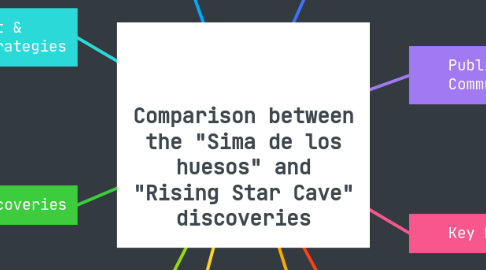
1. Research Projects & major discoveries
1.1. "Rising Star Cave" Discoveries
1.1.1. In 1976, T.Torres found the first human fossils at this site whose systematic excavations began in 1984, uncovering over 7,000 fossils which includes 6,500 bone fragments plus 500 teeth alone;from atleast 28 individuals, mainly attributed to Homo heidelbergensis in the Rising Star Cave system, South Africa. They found remains of atleast 15 individuals, including young and old.
1.2. Research Methodology
1.2.1. Due to the cave's narrow passages, the team developed special techniques and formed "Underground Astronauts" teams to carefully analyze the fossils.
1.3. Behaviour
1.3.1. Bones arranged in the cave suggested possible burial rituals.
2. Public Engagement & Communication Strategies
2.1. Approach
2.1.1. The team used social media, documentories, press releases to reach a global audience influencing widespread interests amongst people.
3. Key Discoveries
3.1. Key Studies
3.1.1. Berger et al.(2023) discussed evidence of Homo neledi's burial practices.
3.2. Publication Venue
3.2.1. Findings appeared in the open-access journal "eLife".
4. Scholarly Reception & Integrity of Research
4.1. Reception
4.1.1. Initial findings, especially regarding burial practices, faced skepticism. Some scholars questioned interpretations, suggesting alternative explanations.
4.2. Research Integrity
4.2.1. The team published findings in open-access journals, promoting transparency, though some debates continue about the evidence's strength
5. Implications for Public Understanding & Human Evolution Research
5.1. Implications
5.1.1. The initial claims suggested Homo naledi engaged in complex behaviours like intentional burial, promoting debates about human ancestoral capabilities. However, some interpretations have been questioned, emphasizing the need for careful analysis.
6. Research Projects & major discoveries
6.1. "Sima de los huesos" Discoveries
6.1.1. In 1976, T.Torres found the first human fossils at this site whose systematic excavations began in 1984, uncovering over 7,000 fossils which includes 6,500 bone fragments plus 500 teeth alone;from atleast 28 individuals, mainly attributed to Homoheidelbergensis."
6.2. Reseach Methodology
6.2.1. Archeologists used traditional digging methods and carefully studied the layers of soil and fossils to understand their context.
6.3. Behaviour
6.3.1. Evidence suggested that they cared for injured group members.
7. Public Engagement & Communication Strategies
7.1. Approach
7.1.1. Findings were mainly shared through conferences and traditional media like news and articles focussing on the scholarly community.
8. Key Discoveries
8.1. Key Studies
8.1.1. Arsuaga et al.(2024) summurized findings from the set.
8.2. Publication Venue
8.2.1. The study was published in "The Anatomical Record".
9. Scholarly Reception & Integrity of Research
9.1. Reception
9.1.1. The discoveries are widely accepted, enhancing our understanding of human revolution. Ongoing discussions focus on species classification and behavioural insights.
9.2. Research Integrity
9.2.1. Studies underwent peer review which ensures credibility in their work.
10. Implications for Public Understanding & Human Evolution Research
10.1. Implications
10.1.1. This sight provides valuable insights into hominin diversity and behaviours in Europe, challenging earlier perceptions of our ancestors.
